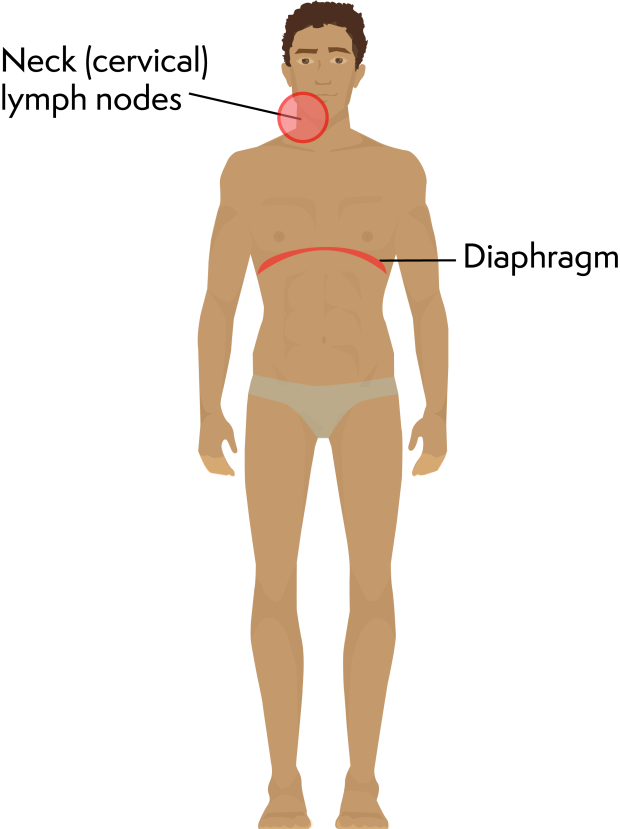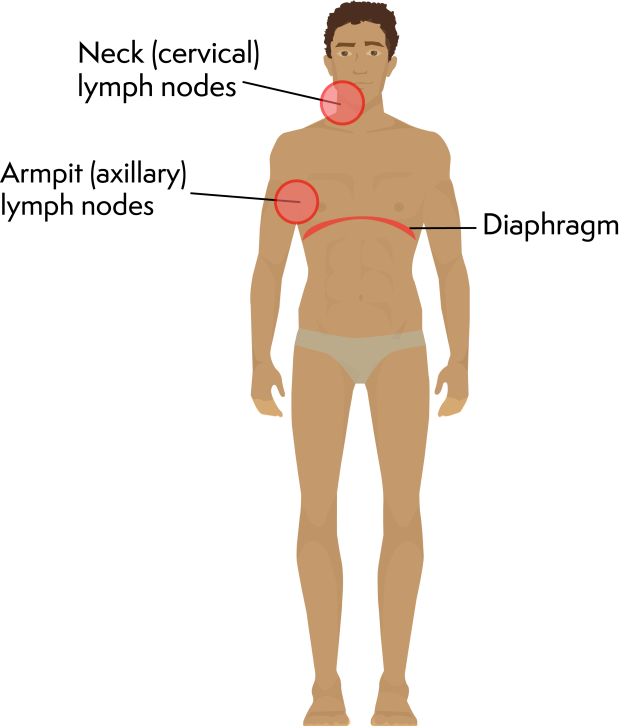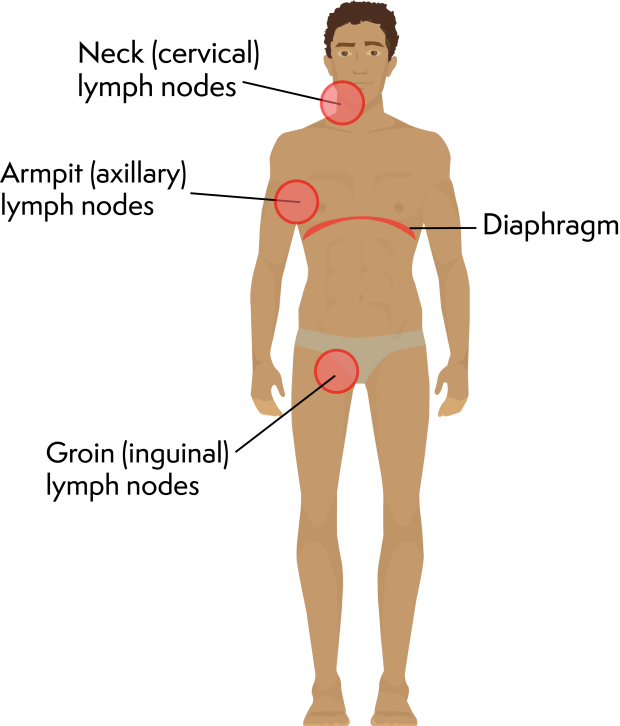Staging of lymphoma
This information is about staging of Hodgkin lymphoma and non-Hodgkin lymphoma in adults and children. Staging is used to work out which parts of your body are affected by lymphoma, so that doctors can plan the treatment most appropriate for you.
On this page
What is staging?
‘Staging’ is the process of working out which parts of your body are affected by lymphoma (how ‘advanced’ your lymphoma is). Tests and scans help doctors to work out the stage of your lymphoma.
Staging lymphoma is important because it helps your medical team plan the most appropriate treatment for you. Different types and stages of lymphoma respond to different treatments.
The same staging system is used for Hodgkin and non-Hodgkin lymphomas, with a few exceptions:
- Staging for non-Hodgkin lymphoma in children is slightly different from staging in adults.
- Staging for chronic lymphocytic leukaemia (CLL), often considered a form of non-Hodgkin lymphoma, uses a different system to other non-Hodgkin lymphomas. This is described in our information about CLL. Small lymphocytic lymphoma (SLL), which is a form of CLL affecting the lymph nodes, is staged the same as other non-Hodgkin lymphomas.
- Skin (cutaneous) lymphomas (lymphomas that start in the skin) behave differently from other lymphomas and are staged differently. Staging of skin lymphomas depends on whether they are B-cell skin lymphomas or T-cell skin lymphomas.
- Waldenström’s macroglobulinaemia (WM), a rare type of non-Hodgkin lymphoma that does not often affect the lymph nodes, is staged differently to the standard staging system. WM is staged by giving a score between 0 and 5, which is based on age and blood test results.
‘Early’ stage and ‘advanced’ stage
Your doctors might talk about ‘early’ stage or ‘advanced’ stage lymphoma.
- ‘Early’ stage means either stage 1 or stage 2 lymphoma.
- ‘Advanced’ stage generally means either stage 3 or stage 4 lymphoma.
The lymphatic system is all over the body, so it is common for lymphoma to be advanced stage when it is diagnosed. However, there is effective treatment for both early and advanced stage lymphomas. Depending on the exact type of lymphoma, your treatment might aim to control or get rid of the lymphoma.
When I was diagnosed I was told I was at stage 4 (advanced or ‘aggressive’) lymphoma. I asked ‘how many stages are there?’ and found it very worrying to hear the answer. However, my consultant explained that stage 4 lymphoma can be very responsive to treatment, and that really helped.
Staging of lymphoma in adults
Staging in adults is the same for Hodgkin lymphoma and non-Hodgkin lymphoma. There are four main stages of lymphoma. These are numbered 1 to 4, sometimes written in Roman numerals as I to IV. Letters after the numbers are sometimes also used.
Staging of lymphoma is based on where the lymphoma in the body is in relation to the diaphragm (the sheet of muscle separating your chest from your tummy).
Stage 1

Stage 1 means that there is lymphoma in only one group of lymph nodes (glands). The diagram above shows these in the neck, but they can be anywhere in the body, either above or below the diaphragm.
Stage 1E lymphoma means that the lymphoma started in a single body organ outside the lymphatic system (for example, the liver) and is in only that organ. This is called extranodal lymphoma.
Stage 2

Stage 2 means there is lymphoma in two or more groups of lymph nodes. These can be anywhere in the body. However, for a diagnosis of stage 2 lymphoma, they must all be on the same side of the diaphragm.
Stage 2E (extranodal lymphoma) means the lymphoma started in one body organ (not in the lymphatic system) and is also in one or more groups of lymph nodes. These must all be on the same side of the diaphragm.
Stage 3

Stage 3 means there are lymph nodes that contain lymphoma on both sides of the diaphragm.
Stage 4

Stage 4 is the most advanced stage of lymphoma. Lymphoma that has started in the lymph nodes and spread to at least one body organ outside the lymphatic system (for example, the lungs, liver, bone marrow or solid bones) is advanced lymphoma.
The spleen and the thymus are part of the lymphatic system, so lymphoma in those organs only is not stage 4.
Letters or numbers after your stage
You might have one of the following after your stage number:
If you have the letter ‘A’ or ‘B’ after your stage
You might have the letters ‘A’ or ‘B’ after your stage. ‘A’ means you don’t have any of the following symptoms:
- unexplained weight loss
- drenching night sweats
- fevers (temperatures above 38°C).
‘B’ means you have one or more of these symptoms. They are sometimes called ‘B symptoms’.
For example, if your lymphoma is stage 2A, you have lymphoma in two or more groups of lymph nodes on the same side of your diaphragm and you haven’t had any of the B symptoms. However, if you have had at least one B symptom, then you have stage 2B lymphoma.
If you have the letter ‘E’ after your stage (Extranodal lymphoma)
Doctors also sometimes use the letter ‘E’, which stands for ‘extranodal’. This means that the lymphoma started in a body organ that is not part of the lymphatic system, for example, in the digestive system or in the salivary glands. It doesn’t include lymphoma that has started in a lymph node and spread to a body organ, which would be stage 4.
If you have the letter ‘S’ after your stage (lymphoma in the spleen and thymus)
The spleen and the thymus are body organs that are part of the lymphatic system. Lymphoma that is in these organs is not regarded as extranodal. If you have lymphoma in the spleen, your doctor might add ‘S’ after your stage. For example, 1S is stage 1 lymphoma that is only in the spleen.
If you have the letter ‘X’ after your stage (bulky disease)
You might see the letter ‘X’ after your number (for example, stage 3X), although not all hospitals use this. This means that one or more of your affected lymph nodes is considered to be large or ‘bulky’.
Staging of lymphoma in children
Lymphoma in children and young people does not always behave the same way as lymphoma in adults. We cover staging of lymphoma in children and adolescents on this page. For further information, we have a separate section on our website about lymphoma in children and young people.
Hodgkin lymphoma in children is staged the same way as in adults. Non-Hodgkin lymphoma is staged slightly differently.
There are four main stages of non-Hodgkin lymphoma in children and adolescents (under 20 years old). They are numbered 1 to 4, sometimes written in Roman numerals as I to IV. Letters after the numbers are sometimes also used.
It’s becoming more common for doctors to talk about ‘early stage’ or ‘advanced stage’ when describing lymphoma in children and young people.
Stage 1
Lymphoma in only:
- one group of lymph nodes, excluding the chest or abdomen (tummy) or
- one body organ outside the lymphatic system (extranodal lymphoma), excluding in the chest or abdomen (tummy) or
- one bone or
- the spleen.
Stage 2
Lymphoma in:
- two or more lymph nodes on the same side of the diaphragm (the sheet of muscle separating your chest from your tummy) or
- one extranodal body organ and a nearby group of lymph nodes or
- the gut (nearby lymph nodes might also be affected as long as the lymphoma is localised and can be removed by surgery).
Stage 3
Lymphoma in:
- two or more extranodal body organs (including bone or skin) or
- lymph nodes above and below the diaphragm or
- the chest or
- the gut (including the liver, spleen, kidneys or ovaries) unless it is localised and can be removed by surgery (see stage 2) or
- around the spinal cord or
- one bone plus an extranodal body organ or distant lymph nodes.
Stage 4
Lymphoma in:
- the central nervous system (brain or spinal cord) or
- the bone marrow.
There might be letters after the stage:
- ‘CNS’ shows that the lymphoma involves the central nervous system (brain or spinal cord).
- ‘BM’ shows that the lymphoma involves the bone marrow.
- ‘B’ show that the lymphoma affects bone.
- ‘EN’ shows that the lymphoma started outside the lymphatic system (extranodal).
- ‘N’ shows that the lymphoma affects the lymph nodes.
- ‘S’ shows that the lymphoma affects the skin.
